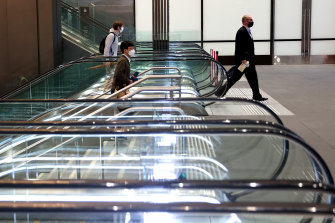Globally, the pandemic will continue until COVID-19 becomes an annual vaccinatable disease whose impact on the wider community can be minimised. A resilient business community needs to learn from the sacrifices made to achieve eradication of COVID-19 in the Australian community.
Rather than repeat these necessary but disruptive public health and social measures, the business community should collectively develop a portfolio of rapid adaptive responses that would reduce transmission and reduce authorities using lockdowns and restrictions to control transmission. Outbreak public health and social measures broadly centre around two classifications of transmission of known and novel infectious agents:
• direct contact with an infected animal, insect or human; and
• indirect contact with contaminated food, surfaces or air.

Workers have begun to return to the office in larger numbersCredit:Bloomberg
Wherever possible, businesses are wise to implement health department’s infection prevention and control guidelines that have already been developed for SARS-CoV-2. Safety starts with knowledge, so train staff about:
• modes of transmission;
• how your built environment can be modified to assist in the prevention of a transmission of an infectious agent;
• the importance of environmental and personal hygiene; and
• safe interaction between staff, between staff and the public, and between the members of the public.
Businesses where either the public or the staff are in close proximity need to develop infection prevention strategies that can be rapidly engaged prior to a continuous rise in case numbers, so that the authorities do not need to choose a pre-emptively highly precautionary response of closing businesses to contain the spread of disease.
Loading
Usually, both transmission modes are considered with viral spread, as it is difficult to identify one route only for transmission. Therefore, to adapt rapidly, businesses should perform an annual or biannual risk analysis on their ability to respond rapidly to all modes. Running scenarios for testing operational readiness will assess the speed and adaptability of each business model to reduce the risk of transmission based on this current highly transmissible novel infectious agent, SARS-CoV-2 and its mutations.
Businesses, along with a whole-of-community approach, must:
• have governance in place to plan;
• have financial resources in place for emergency situations;
• coordinate changes;
• know national and local emergency legislation;
To manage COVID-19 risks in the workplace, businesses need to:
• assess their business capacity to accelerate to emergency readiness and ensure there is continuous trained human resource capacity;
• have a policy in place for emergency business survival; and
• ensure the staff are cognisant of the plan and run simulations.








